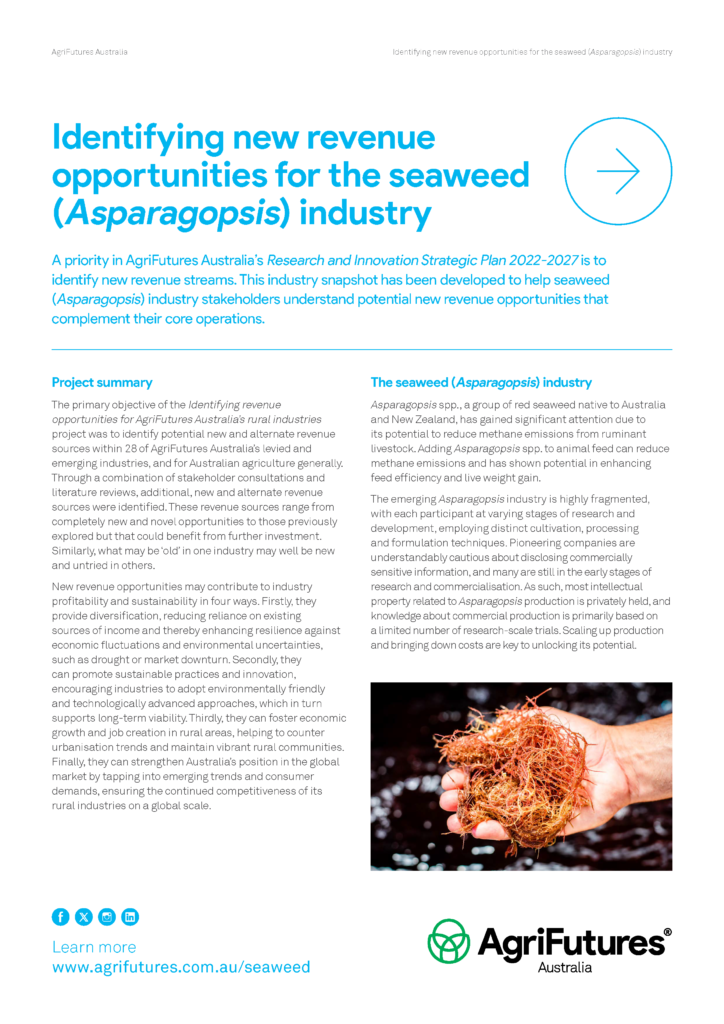Impact case study: Hazelnut investments give confidence to new growers
Australia’s peak hazelnut industry body says the number of growers in Australia is steadily increasing, as ongoing research and development efforts give potential new entrants...

2 pages
Published: 11 Oct 2024
Author(s): AgriFutures Australia
Download report PDF
DownloadThe primary objective of the Identifying revenue opportunities for AgriFutures Australia’s rural industries project was to identify potential new and alternate revenue sources within 28 of AgriFutures Australia’s levied and emerging industries, and for Australian agriculture generally. Through a combination of stakeholder consultations and literature reviews, additional, new and alternate revenue sources were identified. These revenue sources range from completely new and novel opportunities to those previously explored but that could benefit from further investment. Similarly, what may be ‘old’ in one industry may well be new and untried in others.
New revenue opportunities may contribute to industry profitability and sustainability in four ways. Firstly, they provide diversification, reducing reliance on existing sources of income and thereby enhancing resilience against economic fluctuations and environmental uncertainties, such as drought or market downturn. Secondly, they can promote sustainable practices and innovation, encouraging industries to adopt environmentally friendly and technologically advanced approaches, which in turn supports long-term viability. Thirdly, they can foster economic growth and job creation in rural areas, helping to counter urbanisation trends and maintain vibrant rural communities. Finally, they can strengthen Australia’s position in the global market by tapping into emerging trends and consumer demands, ensuring the continued competitiveness of its rural industries on a global scale.
Industry-specific challenges
Specific insights relating to the Australian seaweed (Asparagopsis) industry include:
1. As a nascent industry with significant global potential, scaling production with cost-effective solutions is the primary challenge for most stakeholders throughout the supply chain.
2. The ability of Asparagopsis spp. to reduce methane in livestock has been found to be variable. In the longest feeding trial reported to date, methane emissions from Wagyu steers were reduced by 28% compared to the control when fed an Asparagopsis sp. extract in a canola carrier oil – significantly less than the 90-98% reduction observed in previous trials.
3. Regulatory barriers in different markets, such as those imposed by the US Food and Drug Administration, must be overcome.
Industry-specific opportunities
Specific opportunities relating to the Australian seaweed (Asparagopsis) industry include:
1. Accelerating R&D investment – there has been significant research investment over the years, but the proprietary nature of this information often results in hesitance to disseminate findings. An independent body with the capacity to access confidential intellectual property could facilitate the development of an industry strategic roadmap and focus the distribution of funds.
2. Creating differentiated products catering to the high-end luxury market and socially conscious consumers, leveraging seaweed’s methane-mitigating effects. Examples include Gucci’s premium hide products from low-carbon sources and the ‘Gamechanger’ burger from Grill’d. Initially, these products lead to market differentiation through being premium and sustainably sourced. But over time, their production is expected to become standard business practice.
3. Carbon sequestration and biodiversity markets – research indicates Asparagopsis spp. are capable of capturing carbon from the atmosphere through photosynthesis, which constitutes 40% of its biomass. Validation of these claims can ensure the industry’s credibility and trustworthiness as a carbon-mitigating tool.